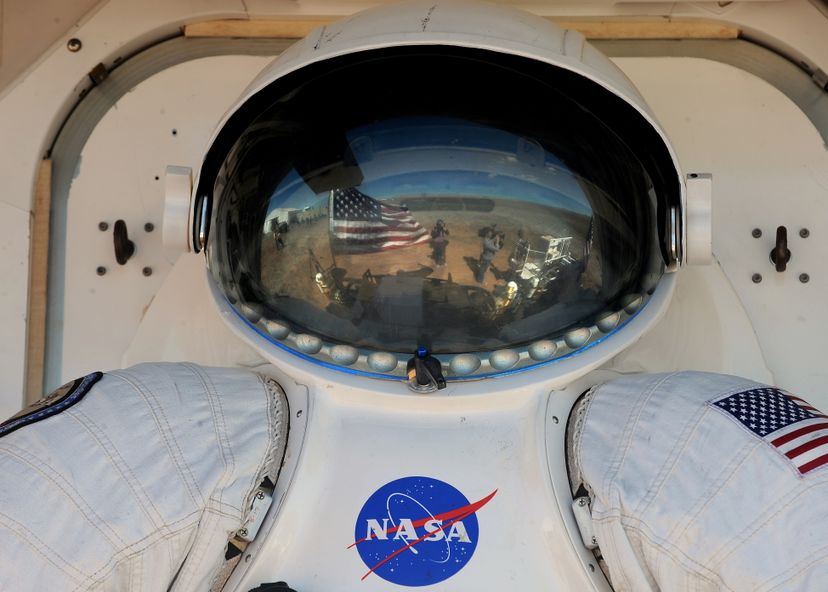
About This Quiz
NASA technology has been inspiring everyday consumer products for decades. Take our quiz to see how much you know about space-inspired technology.The acronym NASA stands for the National Aeronautics and Space Administration.
The U.S. government founded NASA in 1958. The government agency is tasked with advancing science and technology related to aviation and space.
General Foods invented Tang in 1957, one year before NASA was founded. Tang drink mix was used by John Glenn aboard Friendship 7 and on later Gemini missions.
Advertisement
In the 1970s, NASA scientists Charles Yost and Chuck Kubokawa invented temper foam for cushioning and crash protection in spacecraft. Temper foam was released to the public domain in the early 1980s and is now used in a variety of products.
Temper foam can return to its original shape after 90 percent compression.
The NASA Office of the Chief Technologist oversees the Technology Transfer program, which provides NASA-developed technologies to outside entities.
Advertisement
Spinoff was first published in 1976.
Portable cordless vacuums were the direct result of a software program developed by Black & Decker for the Apollo program. The software was developed to maximize the efficiency of a cordless drill used to collect core samples from the surface of the moon.
The Apollo program ended in 1972.
Advertisement
NASA contracted with Marietta Laboratories on a space food project that did not pan out. However, a byproduct of the project was a new technology to make nutritional supplements for infant formula.
Petroleum Remediation Product uses microencapsulating technology to remove petroleum pollutants from water. The PRPs are tiny hollow balls of beeswax that absorb petroleum while floating on the surface of a body of water.
Ribbed swimsuits designed by Speedo used NASA technology that helped swimmers wearing the suits at the 2008 Beijing Olympics win 98 percent of all available swimming medals. A short time after the Beijing Olympics, the suits were banned from competition.
Advertisement
The translucent ceramic material co-developed by NASA and a company called Ceradyne is used to track heat-seeking missiles. The material is also used to make invisible braces.
LED chips, developed by NASA, were originally used to grow plants in space. The LED chips are now used in portable first aid devices carried by frontline military personnel and other first responders.
NASA worked with the Foster Grant company to develop a scratch-resistant coating to protect sensitive equipment like astronaut helmet visors. The coating was later made available for use on eyeglasses.
Advertisement
NASA invented treadmill exercise machines to decrease muscle and bone degeneration of astronauts while in zero gravity.
Thermawing is a technology used on aircraft for ice hazard prevention.
Cochlear implants were invented in the 1970s by Adam Kissiah Jr., a NASA engineer who worked on the space shuttle program.
Advertisement
NASA and Thiokol Propulsion invented a flare that uses surplus rocket fuel to destroy land mines.
A Swiss engineer named George de Mestral invented Velcro in the late 1940s, more than a decade before NASA existed.
NASA made a smoke detector with adjustable sensitivity that Honeywell later made commercially available.
Advertisement
Ongoing funding and space robotics technology from NASA has led to advancements in artificial limbs for both animals and humans.
The NASA Environmental Research Aircraft and Sensor Technology program led to the development of single-crystal silicon solar cells. The advanced solar cells are now commercially available and provide up to 50 percent more power than traditional solar cells.
Diatek put the thermometer on the market in 1991.
Advertisement
NASA researchers working on the Mars Viking spacecraft invented the insulin pump. The device monitors blood sugar levels and releases insulin automatically when needed for people with diabetes.
NASA invented digital image processing for the enhancement of lunar surface photography during the Apollo program. The process was then used to enhance existing computerized tomography and magnetic resonance imaging technology.
According to NASA, the safety grooving on U.S. highways has reduced accidents by 85 percent. The safety grooving was originally invented by NASA to improve the safety of wet runways.
Advertisement
An aluminum composite originally engineered for rocket casings was used in a NASA-developed lightweight breathing system for firefighters.
The Teflon used by NASA in heat shields and space suits was invented accidentally two decades before the founding of NASA by DuPont chemist Roy J. Plunkett in 1938.
The MicroMed DeBakey ventricular assist device, or VAD, was developed with the help of NASA. The device keeps cardiac patients alive by pumping blood through the body until a heart transplant can be performed.
Advertisement